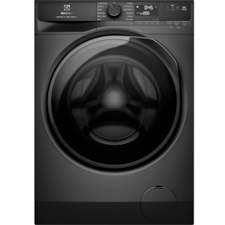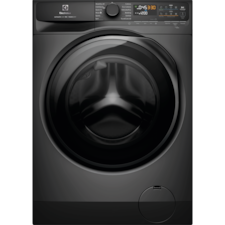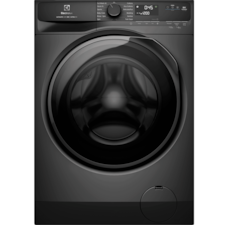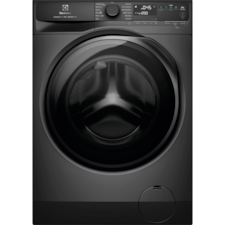Detergent residue on clothes happens when detergent isn’t fully rinsed out during washing. It can leave marks, make fabrics feel sticky or stiff, and cause skin irritation.
Common causes include using too much detergent, overloading the washer, or washing in cold water, which can prevent detergent from dissolving properly.
In this guide, we’ll share easy ways to remove residue and tips to prevent it in future loads.
The impact of detergent residue on clothes
Detergent residue can have various negative effects on both your clothes and skin. When detergent doesn’t fully rinse out, it can lead to several problems:
- Reduced fabric quality: Residue buildup can make clothes feel stiff or sticky, diminishing their softness and comfort.
- Colour fading: Detergent particles can cause fabrics to lose their vibrancy over time, making clothes appear dull and worn out.
- Skin irritation: Residue can be particularly harmful to sensitive skin, leading to itching, rashes, and discomfort.
- Trapped dirt and oils: Residue may hold onto dirt and oils, leaving clothes less clean and potentially damaging delicate fabrics.
By addressing detergent residue issues promptly and using features like UltraMix and IntelliDose from Electrolux, you can minimise these impacts, ensuring fresher, cleaner clothes with every wash.
What causes residue stains and how to prevent it?
Finding white residue on dark clothes after washing or black residue in the washing machine can be frustrating, but these issues are often caused by common laundry mistakes. Understanding what causes detergent residue and how to prevent it can help keep your clothes clean and your washing machine functioning properly.
Too much detergent leads to residue
One of the most common causes of detergent residue is using too much detergent. Excess detergent creates more suds than the washing machine can rinse out, leaving a white residue on clothes. This is especially noticeable on dark fabrics.
To avoid this, use the recommended amount of detergent and adjust it based on the load size and water type. For high-efficiency washers, always use HE detergent.
For more guidance, refer to our guide on How to use laundry detergent in a washing machine.
Incorrect washer settings
Using the wrong wash cycle can also lead to detergent not being rinsed out properly, leaving residue behind. A cycle that’s too short or uses too little water may not fully dissolve the detergent. It’s important to select the correct wash cycle based on the fabric type and soil level. Selecting the appropriate cycle is key. Learn more in our Guide on choosing the right washing machine program.
Overloading the washing machine
When you overload the washing machine, there’s not enough room for clothes to move freely, and water cannot circulate properly. This prevents detergent from dissolving and rinsing out completely, leaving residue on clothes.
Avoid this by not overloading the machine, leave enough space for clothes to tumble and for water to circulate effectively.
Using the wrong type of detergent
Using the wrong detergent for your machine or load can also result in residue. For example, using non-HE detergent in a high-efficiency washer can cause excessive suds, leading to residue buildup. Different types of detergents (liquid, powder, pods) also dissolve at different rates, affecting their effectiveness.
For more details, refer to our comparison of liquid, powder, and pod detergent guide.
By addressing these common causes of residue and adjusting your laundry routine, Error! Hyperlink reference not valid.you can prevent detergent buildup and keep your clothes looking their best.
4 immediate solutions to remove detergent residue

If you find detergent residue on your clothes after washing, there are several effective solutions to help eliminate it quickly. Whether it's visible streaks on dark clothes or a stiff texture on fabric, these methods will help you restore your clothes to their clean, fresh state.
Rub or scrub the stain with a soft brush or cloth
One simple way to remove detergent residue is by gently scrubbing the stain with a soft brush or cloth. Dampen the stained area with warm water and use a soft brush (like a toothbrush) or a clean cloth to gently rub the detergent stains. This loosens the residue and helps remove any soap buildup on the fabric.
Be careful not to scrub too hard, as this could damage delicate fabrics. After scrubbing, rinse the garment thoroughly to remove the loosened detergent.
Re-wash clothes with warm water
If scrubbing isn’t enough, try re-washing your clothes using warm water and less detergent. Here’s how to do it:
- Use less detergent: When re-washing, use about half the normal amount of detergent to prevent further buildup.
- Choose warm water: Warm water helps break down detergent more effectively than cold water, aiding in dissolving any residue.
- Run an extra rinse cycle: After the wash, add an additional rinse cycle to ensure that all detergent is fully rinsed out.
This method ensures that any lingering detergent is washed away, leaving your clothes clean and residue-free.
Use vinegar and baking soda
One of the most effective home remedies for removing detergent residue is using vinegar and baking soda. These common household items can help break down detergent buildup and restore your clothes' softness.
How to use it:
- Add 1 cup of white vinegar to the rinse cycle of your washing machine. Vinegar helps neutralise detergent and softens clothes.
- For stubborn residue, sprinkle baking soda directly onto the stain and let it sit for a few minutes before rewashing. Baking soda works as a gentle abrasive that helps lift detergent particles from the fabric.
Using vinegar and baking soda is especially effective for removing both white residue on dark clothes and any lingering detergent buildup.
Use dish soap to remove residue
For persistent detergent stains, you can also use dish soap to help break down the residue. Dish soap is designed to cut through oils and soap scum, making it an excellent solution for removing detergent buildup.
How to use it:
- Apply a small amount of mild dish soap to the stained area.
- Gently rub the soap into the fabric with a soft cloth or your fingers.
- Rinse thoroughly with warm water to remove the dish soap and detergent residue.
Make sure to only use a small amount, as too much dish soap can create excess suds, leading to more residue if not rinsed properly.
By using these simple methods—scrubbing, re-washing, and applying vinegar, baking soda, or dish soap—you can effectively remove detergent residue from your clothes, leaving them fresh and clean.
Keep your clothes residue-free with Electrolux technology
Ensuring your clothes are free from detergent residue not only improves fabric quality but also protects your skin from irritation. By following the steps in this guide—like using less detergent, choosing the right wash cycle, and applying household remedies—you can eliminate residue and keep your laundry fresh and clean.
Electrolux washing machines make it even easier to prevent detergent buildup with innovative features like UltraMix, which pre-mixes detergent with water for better distribution, and IntelliDose, which automatically adjusts the amount of detergent for each load. These advanced technologies help minimise detergent residue while delivering optimal cleaning results.
With Electrolux, you can enjoy cleaner clothes, protected fabrics, and fewer concerns about residue buildup.
-
- Prevents visible detergent residue with UltraMix.*
- Efficient full-load washing in only 45 mins.
- Sanitise removes 99.99% common bacteria & viruses.*
-
- SensorWash helps remove up to 53 stains.*
- IntelliQuick selects best load based programme.
- King-sized duvet* treated and dried in 60 mins.
-
- Prevents visible detergent residue with UltraMix.*
- Efficient full-load washing in only 45 mins.
- Sanitise removes 99.99% common bacteria & viruses.*
Explore the latest Electrolux washing machines to find the best solution for your laundry needs while contributing to a more sustainable, efficient laundry routine. If you’re looking to upgrade your washer to prevent detergent residue and improve laundry performance, explore Washing machine buying guide to find the best model for your needs.




